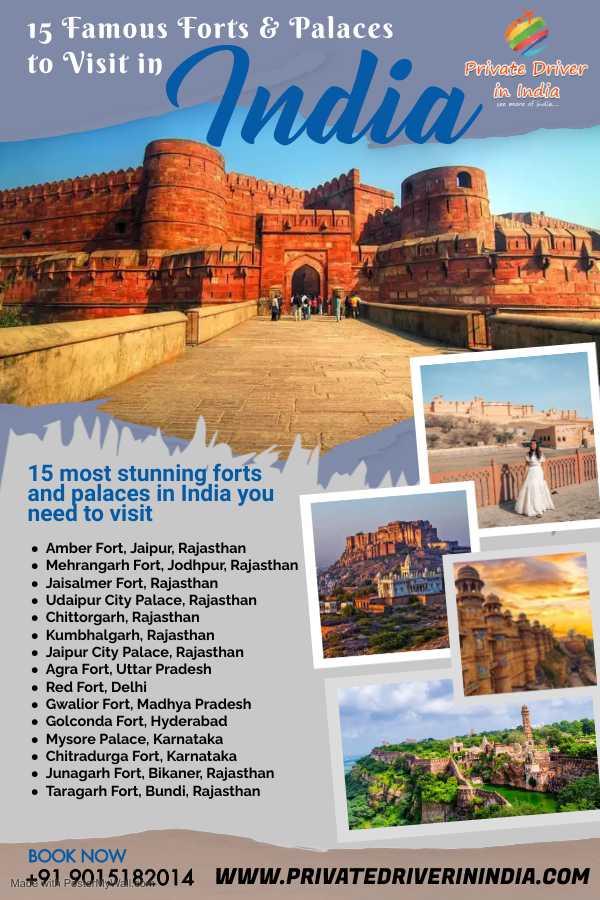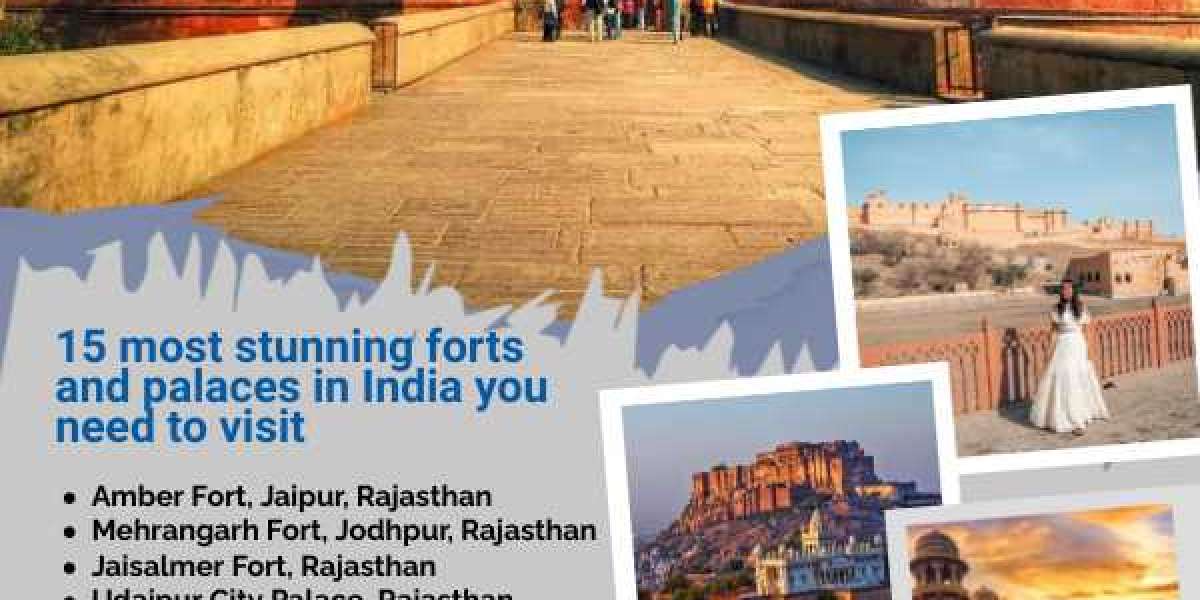
15 Famous Forts Palaces to Visit in India
Forts and palaces are the first things that come to mind while thinking of India. They have been depicted in many photographs and documentaries, after all, and they play a crucial role in the long history of the nation.
It is therefore not unexpected that these architectural wonders are high on travellers' "must-see" lists while visiting India. Rajasthan is home to the majority of India's forts and palaces, which were constructed there by Rajput military ruling clans (before being invaded by the Mughals). They are particularly prevalent in Jaipur's Pink City. As relics from the Mughal era, you can still find them in other states as well.
The former royal proprietors of several of India's palaces have now transformed them into hotels. After their royal position and privileges were removed by the Indian Constitution in 1971, they needed to do this in order to make money. More information on them can be found in this indispensable guide to Indian royal hotels.
Otherwise, continue reading to learn about 14 of India's most spectacular public forts and palaces.
Suggested Tour: Rajasthan Tours, Rajasthan Forts and Palaces Tour, South India Tours, Delhi Sightseeing Tour
Must Read: Top Rajasthan Forts and Places you Must Visit
Amber Fort, Jaipur, Rajasthan
The most famous fort in India is likely Amber Fort. It is located about 20 minutes northeast of Jaipur in the little history town of Amber, also known as Amer. The fort's construction was started by the Rajput king Maharaja Man Singh I in 1592. It was expanded upon and inhabited by successive kings until Jaipur was created and the capital moved there in 1727.
The fort is one of six Rajasthani hill forts that were included in the 2013 UNESCO World Heritage list (the others are Jaisalmer Fort, Kumbhalgarh, Chittorgarh, Ranthambore Fort, Gagron Fort, and Amber Fort). A beautiful fusion of Hindu and Mughal elements can be seen in its construction. The fort complex, which is made of white marble and sandstone, has a number of courtyards, palaces, halls, and gardens. The Sheesh Mahal (Mirror Palace), with its beautifully carved, sparkling walls and ceilings, is generally recognised as its most attractive feature.
Mehrangarh Fort, Jodhpur, Rajasthan
In addition to being among the best forts in India, Mehrangarh Fort is also among its most spectacular and well-kept forts. It was constructed by the ruling Rathore Rajput family, and from its lofty perch on a rocky hill, it towers above the "Blue City." When King Rao Jodha moved his capital to Jodhpur in 1459, work on the fort began. However, following kings continued to work on the project well into the 20th century. The fort's architecture is incredibly varied as a result.
Mehrangarh Fort, in contrast to other Rajput forts that were eventually abandoned, is still under the control of the royal family. They have renovated it and made it into a top tourist destination with a collection of palaces, museums, and eateries. The fort's emphasis on folk music and art sets it different from other forts in Rajasthan. Every day in the fort, several venues host cultural performances. Additionally, the fort serves as the setting for renowned music festivals including the Rajasthan International Folk Festival in October and the yearly World Sacred Spirit Festival in February.
Jaisalmer Fort, Rajasthan
There aren't many places in the world where you can go see a "live" fort, but one of them is Jaisalmer in the Thar desert. Thousands of people have lived in the city's mirage-like golden sandstone fort for many generations. There are numerous stores, hotels, restaurants, a royal complex, historic haveli homes, and temples inside the fort as well.
One of the first forts in Rajasthan was constructed by the Bhati Rajput prince Rawal Jaisal in 1156. It ultimately grew to span the entire hill and changed into a city, which saw a rise in population during times of strife. The fort endured multiple conflicts. However, because of unauthorised building and inadequate drainage, its state is currently fast deteriorating. The fort has had sewage leaking into its foundations, which has made it unstable and led to several of its components collapsing.
Udaipur City Palace, Rajasthan
Romantic The city of palaces and lakes is Udaipur. Mewar monarch Maharana Udai Singh II established it in 1559, and after the Mughals invaded Chittorgarh, the capital of the kingdom was moved there. The City Palace Complex is located in the centre of it, close to Lake Pichola. Notably, the Mewar royal family continues to live there in part today. The development of it into a tourist destination that vividly depicts the history of the Maharanas of Mewar is to be commended. The City Palace Museum is the "jewel in the crown," if you'll excuse the expression.
The City Palace, which consists of the Mardana Mahal (King's Palace) and Zenana Mahal (Queen's Palace), is included in the museum. It is the oldest and largest portion of the City Palace Complex, having been built over a period of four and a half centuries. Along with the rare private royal galleries, artwork, and pictures, the architecture is the main draw.
Chittorgarh, Rajasthan
The enormous Chittorgarh Fort, one of the biggest forts in India, is recognised as the best fort in Rajasthan. It covers over 700 acres! The fort was governed by Mewar monarchs for eight centuries before Akbar, the Mughal Emperor, stormed and took control of it in 1568. In the end, Jehangir, Akbar's eldest son, returned the fort to the Mewars in 1616. They never relocated there, though.
Due to its immensity, it is best to explore the fort by car, and it is advisable to set aside at least three hours to do so. Even if some of it is in ruins, the remnants of its previous splendour may still be seen. Old palaces, temples, towers, and a reservoir where fish can be fed are among the attractions. For a breathtaking view, climb to the top of Vijay Stambha (Tower of Victory).
Chittorgarh is situated in southern Rajasthan, almost halfway between Delhi and Mumbai, and is just over two hours' drive from Udaipur. From Udaipur, it is simple to visit as a day trip or side trip.
Kumbhalgarh, Rajasthan
The second-longest continuous wall in the world, Kumbhalgarh's majestic fort wall is more than 35 kilometres long and is frequently referred to as "The Great Wall of India" (the Great Wall of China is the first).
Maharana Pratap, a legendary ruler and warrior who was born in 1540 in the residence known as Jhalia ka Malia and is the great, great grandson of Rana Kumbha, is another reason why Kumbhalgarh is well-known (Palace of Queen Jhali). He took over as the monarch of Mewar from his father, Udai Singh II, who was also the creator of Udaipur. He refused to give in to the Mughals despite Emperor Akbar's negotiations, in contrast to many other local kings. This led to the legendary Haldi Ghati fight in 1576, which was significant to the history of India.
The fort is located just over two hours drive north of Udaipur, in Rajasthan's Rajsamand district. It's popularly visited on a day trip or side trip from Udaipur. It's possible to hire a car there from one of the numerous travel agencies. Many people combine visiting Kumbhalgarh with Haldi Ghati or the Jain temples at Ranakpur.
Jaipur City Palace, Rajasthan
Maharaja Sawai Jai Singh II primarily constructed the City Palace Complex between 1729 and 1732, and it is located in the heart of Jaipur's Old City. He had been effectively governing from the adjacent Amber Fort, but in 1727 he decided to move his capital to Jaipur due to growing population and water scarcity.
While the remainder of the palace has been transformed into the Maharaja Sawai Man Singh II museum, the royal family still resides there in the Chandra Mahal portion (where their family flag is flown when the Maharaja is in residence). You can take the Royal Grandeur trip within the interior of the Chandra Mahal for a substantial cost (2,500 rupees for foreigners and 2,000 rupees for Indians). If so, you'll just have to settle for touring the remainder of the palace.
Agra Fort, Uttar Pradesh
Despite the Taj Mahal's terrible overshadowing of it, Agra Fort is a moving precursor to the masterpiece and should be viewed before it. The fort was the first substantial Mughal fortress in India, and during the height of the Mughal empire, it served as the capital of four generations of powerful Mughal kings. Additionally, it received UNESCO World Heritage status in 1983, making it one of the earliest places in India to do so.
Emperor Akbar built the fort in its present configuration when he chose to strategically establish a new capital in Agra in the 16th century. He primarily built it as a military outpost. Later, during the 17th century, Emperor Shah Jahan, Akbar's grandson, constructed the sumptuous white marble palaces and mosques. (He loved white marble so much that he used it to build the Taj Mahal.)
Red Fort, Delhi
The Red Fort, one of Delhi's most well-known landmarks and top attractions, serves as both a potent symbol of independent India and a stark reminder of the Mughal era when India was under their authority. In 1648, it was completed. According to his ambition and opulent tastes, Emperor Shah Jahan designed it to mimic the Red Fort in Agra but on a far bigger scale. The Red Fort was designated a UNESCO World Heritage Site in 2007 to reflect its importance.
The position of the fort in Old Delhi, across from Chandni Chowk, is intriguing and adjacent to Jama Masjid, one of the largest mosques in India and another magnificent Old City asset. During the Navaratri festival and Dussehra, the area around the Red Fort really comes to life with festivals and Ram Lila performances.
Gwalior Fort, Madhya Pradesh
The fort's history can be traced as far back as 525. Over the years, it was subjected to many attacks and had many different rulers. It wasn't until the reign of the Rajput Tomar dynasty that the fort really rose to prominence, and was built to its current scale and grandeur. During this time, ruler Raja Man Singh Tomar crafted one of the fort's main highlights, Man Mandir Palace, between 1486 and 1516. Its outer walls are distinctively decorated with blue mosaic tiles and rows of yellow ducks. Later on, the Mughals used the fort as a prison during their rule.
The Hathi Pol (Elephant Gate), the fort's most impressive gate, is on its eastern flank and connects to the Man Mandir palace. However, getting there entails a hard climb past a number of additional gates and is only accessible on foot. Urvai Gate, the western gate, is easily accessible by car but isn't quite as magnificent. However, don't skip the magnificent Jain sculptures carved into the rock along the way up. The fort's outdoor amphitheatre hosts a sound and light display every evening.
Golconda Fort, Hyderabad
The Golconda Fort ruins, which lie outside of Hyderabad, are a well-liked day trip from the city. The Kakatiya Kings of Waranga erected the fort in the 13th century, when it was once a mud fort. However, it peaked from 1518 and 1687 during the Qutub Shahi dynasty.
Golconda Fort later became well-known for its diamond market during the 17th century. The region has produced some of the most valuable diamonds ever discovered.
There are a lot of drawbridges, temples, mosques, royal rooms and halls, stables, and drawbridges among the fort's remains. Its bastions still have cannons atop several of them. The fort's architecture and unique acoustic design, though, are what make it very fascinating. The main entrance to the fort, Bala Hissar Gate, can be heard clearly more than a kilometre distant if you clap while standing in a specific location underneath the dome at Fateh Darwaza (Victory Gate). Evidently, this was done to alert the royal inhabitants of an impending attack.
Mysore Palace, Karnataka
The Maharaja's Palace, often known as the Mysore Palace, is a relatively new palace in Indian terms. Henry Irwin, a British architect, created the design, and it was built between 1897 and 1912. The Wodeyar monarchs, who initially constructed a palace in Mysore in the fourteenth century, are the owners of the current palace. It was, however, repeatedly destroyed and rebuilt. Fire destroyed the former palace, which was constructed of wood in a Hindu style. The current palace was built in the Indo-Saracenic style, which combines Rajput, Hindu, Islamic, and Gothic elements.
The marble domes are the palace's most striking feature. Some could argue that its opulent interiors are excessive. There are marriage halls, antique doll pavilions, armouries, galleries of royal paintings, and collections of sculptures and antiquities in addition to private and public audience halls. Unfortunately, taking pictures inside is not allowed.
Chitradurga Fort, Karnataka
On the way to Hampi from Bangalore or Mysore, Chitradurga Fort is worth the stop. You might easily spend an entire day exploring its huge area and discovering all of the legends connected to it. There is a lot of climbing and walking involved, so make sure you wear comfortable shoes!
The fort is located on a group of rugged hills that cover 1,500 acres. It was built gradually between the 10th and the 18th centuries by kings of numerous dynasties, including the Rashtrakutas, Chalukyas, Hoysalas, Vijayanagars, and Nayakas. However, when the Nayakas acquired control of Chitradurga following the collapse of the Vijayanagar empire, they carried out the majority of the fortification construction during the 16th and 18th centuries. The ramparts of the fort, which are formed of enormous pieces of granite that mix in with the surrounding stones, give it the nickname "stone fort." The fort appears to include 35 secret passageways and four invisible corridors in addition to its multiple concentric walls, gateways, and entrances. Furthermore, 2,000 watchtowers!
Junagarh Fort, Bikaner, Rajasthan
Despite being one of Rajasthan's less well-known forts, Junagarh Fort is no less spectacular. It's one of the few forts in India that isn't located on a hilltop, which makes it particularly noteworthy. The city of Bikaner developed up around the fort, which is in the middle of it.
The fort was constructed by Raja Rai Singh, the sixth monarch of Bikaner, between 1571 and 1612. He was a widely-traveled expert in the arts and architecture, and the magnificent constructions of the fort are evidence of this expertise. Expensive palaces, ladies’ quarters, audience halls, temples, and pavilions were later erected by emperors.
Chintamani was the fort's original name. When the royal family moved to Lalgarh Palace beyond the fort's boundaries at the beginning of the 20th century, the fort was renamed Junagarh (Old Fort). They still keep it up, though, and have let people visit a portion of it. There are two museums with numerous interesting royal antiques and memorabilia, as well as guided tours available.
Taragarh Fort, Bundi, Rajasthan
As Bundi castle as well. In the fourteenth century, king Prithviraj Chauhan constructed it. situated in northern Bundi, India, atop a hilltop. The castle is not well kept, although it is not in total disrepair; rather, it has a worn-out architecture.
Despite its unimpressive exterior, its inner beauty is still shining today. Beautiful murals and paintings cover the castle walls in abundance. There are so many tunnels, both above ground and below, that they form a maze and some have been declared inaccessible for fear of getting lost. This adds to the mystery of the place.








